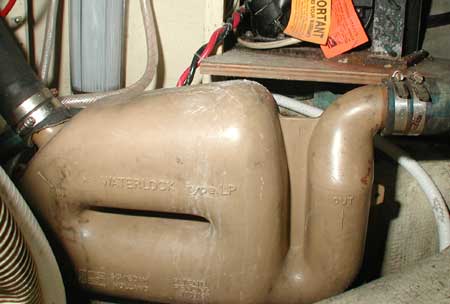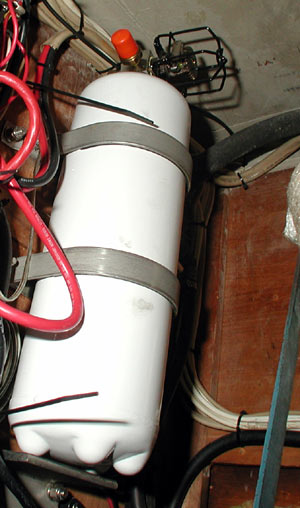| Engine:
Perkins 4-107 Diesel |
|||
| Perkins 4-107 built in 1973. This power plant
has been extremely reliable. The biggest difference between the 4-108 and
the 4-107 is that the 4-107 uses hand pressed cylinder sleeves. Sounds
like a great idea for a long range cruiser, the down side is that the seal
between the oil and the antifreeze is a couple of large O-Rings.
Apparently if the engine is significantly overheated these can start to
leak.
The serial number for the engine aboard Botany Bay is 107U42611. From the Perkins shop manual it can be inferred that the engine displaces 107 cubic inches, was built in the United Kingdom, and has an engine number of 42611. The year of production was not incorporated into the Perkins serial number until 1975. The engine and reduction gear weigh approximately 570lb (259kg) not including the V-Drive which weighs something like 60-80lbs. The engine is rated at 48shp (37kW) at 4000 rev/min [high speed pleasure craft], 45shp (36kW) at 3600 rev/min [pleasure craft], and 37shp (30kW) at 3000 rev/min [commercial craft]. The sump requires 4.2 quarts of oil to refill or 5.1 quarts of oil after a rebuild. The cooling system contains 7.8 quarts of coolant. The maintenance schedule I follow is: Every Hour and at startup: Every 8 hours or daily: Every 100 hours or 3 months: Every 400 Hours or 12 months: Every 2-3 years: When I originally purchased Botany Bay she had a 18" x 12pitch fixed three bladed prop and the maximum RPM which the engine could attain in gear with a clean bottom was 2200 rev/min. When I replaced the propeller with a 18" Maxprop I set the prop at 19 degrees (or 11.7 pitch) and can achieve 2700 rev/min and cruise comfortably at 2100 rev/min. I reset the prop to 17 degrees (or 10.4 pitch) and can achieve 3200 rev/min and cruise comfortably at 2600 rev/min which is a bit noisy. I finally settled for 18 degrees (or 11.0 pitch) and can achieve 2900 rev/min and cruise comfortably at 2350 rev/min. As the pitch becomes lower (flatter) the efficiency of the propeller becomes less with the ideal being closer to 12 or 13 pitch. However, the width of the deadwood (back of the keel) results in a desire for a somewhat larger propeller than might otherwise be desireable. Plan to add a chart of speed vs. RPM for various pitch settings along with maximum achievable RPM for each pitch setting. Note, however, that with the alternator loading the engine heavily (providing 80 amps @ 14.4V) the engine will gradually overheat if run for extended periods (2-4 hours) heavily loaded. If motoring for extended periods at high speed is required either reduce alternator output or make sure that the batteries are mostly charged before setting out. Normally I simply reduce rev/min by about 200 when charging and don't have any difficulties. Plan to add a chart of temperature vs. time with and without the alternator loaded at cruising RPM. A nice feature of the Perkins 4-107 is it's ability to pass air bubbles in the fuel lines. This is the result of returning a significant amount of fuel back through the return lines. By comparison newer Yanmar engines don't even require a fuel return line but are very sensitive to air bubbles in the fuel lines. Interesting observation, a new Yanmar seems not to suffer from the sensitivity to air in the fuel. This observation was with a 30HP Yanmar on the Tayana 42 "Wings" which had significant trouble if there was any air in the lines at all. On the other hand, the new 56HP Yanmar in the Northwind 43 "Alegria" seems to self bleed without any trouble. Replaced the primary fuel filters (carefully filling them before installation) and it ran without difficulty, replaced the secondary fuel filter on the engine and it ran for a bit, stopped due to air in the injection system, and with a minimal amount of cranking bled itself and started without any manual bleeding, a significant improvement. Phone 206-789-4600. Ask for Larry Stewart of Stewart's Marine Engine and Machine Works. He's got a few older engines in stock and parts for almost anything Perkins ever built. A genuine resource for Perkins owners. The 2004/2005 winter refit included
extensive refurbishment of Botany Bay's engine room. Sound proofing was
added as well as hard walls on all sides so that the engine room is now separate
from the rest of the aft machinery spaces. Various small projects were
completed including: Replacement Oil Pressure Sender: Sierra 18-5899 0-80PSI Replaces Crusader 700425, Pleasurecraft RO20001, Mercury/Mariner 90806, OMC 982650 $32 Replacement low oil pressure alarm switch: Standard Motor Products PS12 Switch/Interruptor/Commutateur $12 Replacement Fuel Pump: ULPK0014 $60, hand written note 7B3 Replacement Belt Gates XL series 9405 (12.5/13mm x 1038mm)
|
The waterlock is part of the exhaust system, to the left the exhaust gases mixed with raw water coolant come down into the waterlock. As the amount of water increases the outflow exhaust port is covered with water and exhaust backpressure causes the water to be pushed out of the waterlock, through I high gooseneck to prevent following seas from flooding the engine and then overboard.
Engine Room Fire Suppression is provided by this xx cubic foot FM-??? based automatic fire extinguisher. |
||

